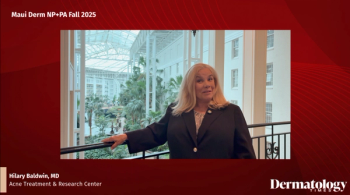
Smoking and rosacea link still hazy
Several studies present data that contradicts one another when examining the possible link between rosacea development and smoking.
The decision on whether smoking causes rosacea or not is still hazy, according to two recent studies that investigated the relationship between rosacea and smoking.
In one study1 published in the Journal of the European Academy of Dermatology and Venereology, researchers from the Taiwan National Health Interview Survey chose 59,973 survey participants who have never experienced symptoms of rosacea in four rounds (2001, 2005, 2009 and 2013). Of this survey population, 73.7% of participants say they have never smoked, 21.6% are current smokers and 4.7% say they are former smokers.
At the conclusion of the study, investigators found 379 total participants had developed rosacea which consisted of 343 never smokers, 31 current smokers and five former smokers after a mean follow-up of 10.8 years. Also, the incidence rates/100,000 person-years were 71.86 among never smokers, 21.64 among current smokers and 19.71 among former smokers.
Results of the study demonstrate a significantly lower risk of developing rosacea in current smokers than individuals who have never smoked. Moreover, this lower risk was consistent when investigators considered the number of cigarettes smoked. Results show current smokers who smoked more than 15 cigarettes a day were less likely to develop rosacea compared to current smokers who smoked less than 15 cigarettes per day.
However, this study’s results contradict data from another study2 conducted by investigators at Xiangya Hospital in Changsha, China which examined 1,180 patients with rosacea and 1,008 patients without rosacea in the Department of Dermatology at Xiangya Hospital and sought to observe drinking and smoking habits of the groups.
While drinking had no effect on the incidence of rosacea, results of the study demonstrate that former and current smokers are 1.76 times more likely to have rosacea than individuals who have never smoked before. The study also found that the risk of developing rosacea was higher among female participants and patients 25-34 years old.
Meanwhile, various other studies add to this confusing narrative of the possible relationship between rosacea and smoking. For instance, a study3 from 2018 discovered a connection between rosacea severity and the number of cigarettes smoked by patients who were former smokers.
While in another study4 from 2016, investigators found that among 400 participants, the rate of smoking was notably higher in patients with rosacea than in patients without the disease. Researchers also divided patients with rosacea into three National Rosacea Society Expert Committee classification subgroups: erythematotelangiectatic (ETR), papulopustular (PPR), and phymatous rosacea (PhR). ETR (43.5%) was found to be significantly higher among active smokers than PhR and PPR (P < 0.001), and this subtype was found more commonly in females, according to the study.
“While a significantly increased risk of developing rosacea among smokers was observed in this study, ETR seems to be the disease of active smokers,” writes the study’s authors.
On the other hand, a large-scale epidemiology study5 from 2012 was conducted in the United Kingdom (UK) by the British Association of Dermatologists. Over 60,000 rosacea cases and over 60,000 controls were identified with an overall incidence rate for diagnosed rosacea of 1.65 per 1,000 person-years. The researchers discovered that smokers had a significantly lower risk of developing rosacea versus individuals who did not smoke, and former smokers had a slightly increased risk.
While each individual study indicates a possible link between smoking and rosacea, all of the studies call for more research in order to make a clear-cut decision on the relationship among the two.
Disclosures: The authors of the studies report no relevant disclosures.
References:
1. Dai Y, Yeh F, Chou Y, et al. (2020), Cigarette smoking and risk of rosacea: a nationwide population‐based cohort study. J Eur Acad Dermatol Venereol 2020 May 13. doi: 10.1111/jdv.16595.
2. Wang Y, Zhao Z, Liu F, Xie H, Li J, Wang B. Relationship between the incidence of rosacea and drinking or smoking in China[J]. J Cent South Univ (Med Sci) 2020 Feb 28;45(2):165-168. English, Chinese. doi: 10.11817/j.issn.1672-7347.2020.180759
3. Alinia H, Tuchayi SM, Patel NU, et al. Rosacea Triggers: Alcohol and Smoking. Dermatol Clin 2018 Apr;36(2):123-126. doi: 10.1016/j.det.2017.11.007.
4. Kucukunal A, Altunay I, Erkul J, et al. Is the effect of smoking on rosacea still somewhat of a mystery? Cutan Ocul Toxicol 2016;35(2):110-4. doi: 10.3109/15569527.2015.1046184.
5. Spoendlin J, Voegel JJ, Jick SS, Meier CR. A study on the epidemiology of rosacea in the U.K. Br J Dermatol 2012;167(3):598-605. doi:10.1111/j.1365-2133.2012.11037.
Newsletter
Like what you’re reading? Subscribe to Dermatology Times for weekly updates on therapies, innovations, and real-world practice tips.

















